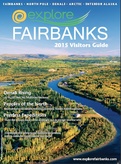TOP THINGS TO DO IN FAIRBANKS , AK
|
Official Fairbanks Travel Site Fairbanks is the largest city in the Interior region of Alaska, and second largest in the state, after Anchorage. Located on the rustic Chena River , Fairbanks is the northernmost city in the United States, lying less than 120 miles (190 km) south of the Arctic Circle. Many tourists arrive in town in the summer months via the Alaska Railroad on a land leg of their Alaska cruisetour. Others arrive in the colder months, many in fall and spring, to see the spectacular aurora borealis that are especially prevalent at this latitude. The summer months are mild and warmer than on the coast further south. Typical highs are in the low 70′s Fahrenheit (low 2o’s Celsius). Summer days are very, very long, with up to 22 hours of sunlight. |
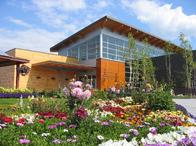
Morris Thompson Cultural and Visitors Center
For those interested in learning about Interior and Arctic Alaska as well as Native culture, the Morris Thompson Cultural and Visitors Center is a must-have experience when visiting Fairbanks. The mission of the attraction is to celebrate the people and culture of Interior Alaska while also promoting the local economy and acting as a community gathering place to exchange cultural ideas.
For those interested in learning about Interior and Arctic Alaska as well as Native culture, the Morris Thompson Cultural and Visitors Center is a must-have experience when visiting Fairbanks. The mission of the attraction is to celebrate the people and culture of Interior Alaska while also promoting the local economy and acting as a community gathering place to exchange cultural ideas.
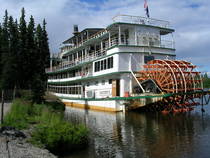
Riverboat Discovery
Climb on board an authentic Alaskan sternwheeler, the Riverboat Discovery, and take a journey back in time along the Chena and Tanana Rivers. Since 1950, the Binkley family has operated riverboat tours in Fairbanks; now you can cruise out into nature with third- and fourth-generation captains and experience the area's history and beauty firsthand. Take a tour with native Alaskans in a traditional village and meet some of the pioneers who call this land home.
Climb on board an authentic Alaskan sternwheeler, the Riverboat Discovery, and take a journey back in time along the Chena and Tanana Rivers. Since 1950, the Binkley family has operated riverboat tours in Fairbanks; now you can cruise out into nature with third- and fourth-generation captains and experience the area's history and beauty firsthand. Take a tour with native Alaskans in a traditional village and meet some of the pioneers who call this land home.
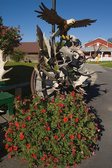
Pioneer Park
It's theme-park time: Pioneer Park lets you walk back to an era when gold was king and narrow-gauge railroads were the way to get around. You'll find museums, a riverboat, a native Alaskan village, a mining operation, and more. Play golf on the world's farthest north mini-golf course, or take a lazy ride on the Crooked Creek and Whiskey Island Railroad.
It's theme-park time: Pioneer Park lets you walk back to an era when gold was king and narrow-gauge railroads were the way to get around. You'll find museums, a riverboat, a native Alaskan village, a mining operation, and more. Play golf on the world's farthest north mini-golf course, or take a lazy ride on the Crooked Creek and Whiskey Island Railroad.

Trans-Alaska Pipeline Visitor Center
The Trans-Alaska Pipeline is a 48-inch oil pipeline that traverses 800 miles (1,300 kilometers). It was built by the Alyeska Pipeline Service Company in 1977 to transport crude oil from Prudhoe Bay’s oil fields to a port in Valdez to be loaded onto tankers and shipped to U.S. refiners. The cost to construct the pipeline was $8 billion, making it one of the largest privately-funded construction projects in Alaska. Moreover, it’s one of the largest pipeline systems in the world, and because much of the ground that it is laid on is frozen sections of the pipeline are either built above ground or buried and insulated.
The Trans-Alaska Pipeline is a 48-inch oil pipeline that traverses 800 miles (1,300 kilometers). It was built by the Alyeska Pipeline Service Company in 1977 to transport crude oil from Prudhoe Bay’s oil fields to a port in Valdez to be loaded onto tankers and shipped to U.S. refiners. The cost to construct the pipeline was $8 billion, making it one of the largest privately-funded construction projects in Alaska. Moreover, it’s one of the largest pipeline systems in the world, and because much of the ground that it is laid on is frozen sections of the pipeline are either built above ground or buried and insulated.
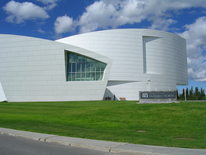
Museum of the North
The expanded museum is visible from vantage points across town and will make a striking addition to the Fairbanks skyline. Museum of the North is housed in an impressive modern building and has exhibits on everything from Alaskan geograhy to Alaskan art.
The expanded museum is visible from vantage points across town and will make a striking addition to the Fairbanks skyline. Museum of the North is housed in an impressive modern building and has exhibits on everything from Alaskan geograhy to Alaskan art.
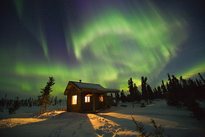
Fairbanks Aurora Borealis
Bright, energetic curtains of yellow, green, red or even purple light brighten our night skies regularly. Fairbanks is situated within a ring-shaped region around the North Pole called the auroral oval. This location provides a terrific balance of occurrence, frequency and activity. Plus, our continental climate offers many more clear nights than you would find in a coastal area. While intensity varies, the most common yellow-green glow occurs heavily between late August and April. Prime viewing time is late evening through the wee hours of the morning.
Bright, energetic curtains of yellow, green, red or even purple light brighten our night skies regularly. Fairbanks is situated within a ring-shaped region around the North Pole called the auroral oval. This location provides a terrific balance of occurrence, frequency and activity. Plus, our continental climate offers many more clear nights than you would find in a coastal area. While intensity varies, the most common yellow-green glow occurs heavily between late August and April. Prime viewing time is late evening through the wee hours of the morning.
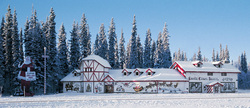 Santa Claus House
Santa Claus House
Santa Claus House
Santa’s workshop DOES exist, in North Pole, Alaska! Okay, so technically speaking, the actual North Pole is stuck in some chunk of floating ice in the Arctic Ocean: but who wants to take an 80 hour dog sled ride to the middle of nowhere when you could take a comfy car or sleigh ride to this cozy town in the interior of Alaska to see the Santa Claus House ?! What started out as a trading post and official post office for the city of North Pole (13 miles south of Fairbanks) now serves as a community meeting spot and Christmas souvenir superstore! While some people enjoy seeing the 42 foot tall 900 lb. Santa statue, my favorite thing about North Pole is that the streets are lined with candy cane light poles – so magical!
Santa’s workshop DOES exist, in North Pole, Alaska! Okay, so technically speaking, the actual North Pole is stuck in some chunk of floating ice in the Arctic Ocean: but who wants to take an 80 hour dog sled ride to the middle of nowhere when you could take a comfy car or sleigh ride to this cozy town in the interior of Alaska to see the Santa Claus House ?! What started out as a trading post and official post office for the city of North Pole (13 miles south of Fairbanks) now serves as a community meeting spot and Christmas souvenir superstore! While some people enjoy seeing the 42 foot tall 900 lb. Santa statue, my favorite thing about North Pole is that the streets are lined with candy cane light poles – so magical!
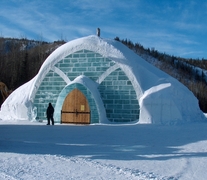 Aurora Ice Museum
Aurora Ice Museum
Aurora Ice Museum at Chena Hot Spring Resort
This amazing ice hotel in Fairbanks, Alaska has some issues with the fire marshall, thus they cannot promote their rooms. You can still ask for their rooms and they can guarantee a very unique experience with an indoor igloo, ice tree, ice bar, ice pulpit, ice sculptures, and ice chandeliers. You can also relax in their outdoor hot springs.
Other activities include learning about renewable energy, ice museum tours, dog kennel tour, dog sled rides, skiing, ice skating, snow machine tours, snow coach tours, and flight seeing.
The first Aurora Ice Hotel in Fairbank s was built in 2004 and later renamed as the Aurora Ice Museum.
This amazing ice hotel in Fairbanks, Alaska has some issues with the fire marshall, thus they cannot promote their rooms. You can still ask for their rooms and they can guarantee a very unique experience with an indoor igloo, ice tree, ice bar, ice pulpit, ice sculptures, and ice chandeliers. You can also relax in their outdoor hot springs.
Other activities include learning about renewable energy, ice museum tours, dog kennel tour, dog sled rides, skiing, ice skating, snow machine tours, snow coach tours, and flight seeing.
The first Aurora Ice Hotel in Fairbank s was built in 2004 and later renamed as the Aurora Ice Museum.
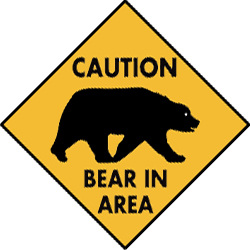
The Essentials for Traveling in Bear Country
One of the things that makes Alaska so special is that all three species of North American bears flourish here, providing a good chance for visitors to actually see one. Even if you don't see one, you will never be far from one, because Alaska is bear country.
1. Avoid surprising bears; look for signs of bears in the area and make plenty of noise.
2. Avoid crowding bears; respect their "personal space."
3. Avoid attracting bears through improper handling of food or garbage.
4. Plan ahead, stay calm, identify yourself, and don't run.
In most cases, bears are not a threat, but they do deserve your respect and attention. When traveling in bear country, keep alert and enjoy the opportunity to see these magnificent animals in their natural habitat.
One of the things that makes Alaska so special is that all three species of North American bears flourish here, providing a good chance for visitors to actually see one. Even if you don't see one, you will never be far from one, because Alaska is bear country.
1. Avoid surprising bears; look for signs of bears in the area and make plenty of noise.
2. Avoid crowding bears; respect their "personal space."
3. Avoid attracting bears through improper handling of food or garbage.
4. Plan ahead, stay calm, identify yourself, and don't run.
In most cases, bears are not a threat, but they do deserve your respect and attention. When traveling in bear country, keep alert and enjoy the opportunity to see these magnificent animals in their natural habitat.
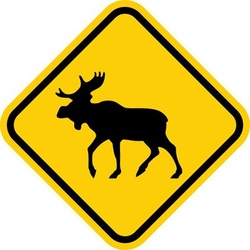
Moose Safety
Visitors to Alaska are often concerned about encountering bears; yet more people each year are injured by moose than by bears.Moose aren't inherently aggressive, but will defend themselves if they perceive a threat. When people don't see moose as potentially dangerous, they may approach too closely and put themselves at risk.
1. What to do if you observe an aggressive moose. Tell others in the area. Call local Police at 911.
2. Recognize the Signs of an Aggressive Moose. The moose stops eating and stares at you. The moose lays its ears back and raises the hair on its hump. The moose licks its lips or clicks its teeth. The moose lowers its head and walks towards you.
3. What to do if attacked by a moose. Run and place a strong barrier between you and the moose. If you get knocked to the ground, curl up in the fetal position. Protect your head with your arms. Do not move until the moose is a safe distance from you. Use any means you can to protect yourself from an aggressive moose.
4. How to observe moose safely. Watch moose from a safe distance. Control pets, remember moose view dogs as wolves a natural predator. Avoid loud noises and don’t chase or harass moose for action shots. Don’t crowd or feed moose. The harassment or feeding of a wild animal is a crime in the State of Alaska. Don’t walk between a cow moose and a calf.
5. Don’t underestimate moose. Moose may appear docile but they are very large and agile wild animals. Moose can weigh up to 1200 pounds and can run 30 mph. Moose use their hooves and antlers for defense. Enjoy watching moose from a safe distance.
Visitors to Alaska are often concerned about encountering bears; yet more people each year are injured by moose than by bears.Moose aren't inherently aggressive, but will defend themselves if they perceive a threat. When people don't see moose as potentially dangerous, they may approach too closely and put themselves at risk.
1. What to do if you observe an aggressive moose. Tell others in the area. Call local Police at 911.
2. Recognize the Signs of an Aggressive Moose. The moose stops eating and stares at you. The moose lays its ears back and raises the hair on its hump. The moose licks its lips or clicks its teeth. The moose lowers its head and walks towards you.
3. What to do if attacked by a moose. Run and place a strong barrier between you and the moose. If you get knocked to the ground, curl up in the fetal position. Protect your head with your arms. Do not move until the moose is a safe distance from you. Use any means you can to protect yourself from an aggressive moose.
4. How to observe moose safely. Watch moose from a safe distance. Control pets, remember moose view dogs as wolves a natural predator. Avoid loud noises and don’t chase or harass moose for action shots. Don’t crowd or feed moose. The harassment or feeding of a wild animal is a crime in the State of Alaska. Don’t walk between a cow moose and a calf.
5. Don’t underestimate moose. Moose may appear docile but they are very large and agile wild animals. Moose can weigh up to 1200 pounds and can run 30 mph. Moose use their hooves and antlers for defense. Enjoy watching moose from a safe distance.
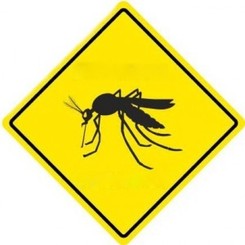
Mosquitos in Alaska
No question: mosquitoes can be a pain in the neck. And the arm. And the leg. And just about anywhere we forget to—or don't want to—cover up. Alaska has 35 species of mosquito, and all but a few will be more than happy to nibble on humans. But mosquitoes are only really an issue for Alaska visitors from the second week in June to the last week in July, and even then, they're not nearly as bad as myth would have it.
Alaska Mosquito Tips
If you do find yourself in a heavy congregation (mosquitoes seem to be most active at dawn and twilight), there are easy steps you can take to block out the nuisance:
No question: mosquitoes can be a pain in the neck. And the arm. And the leg. And just about anywhere we forget to—or don't want to—cover up. Alaska has 35 species of mosquito, and all but a few will be more than happy to nibble on humans. But mosquitoes are only really an issue for Alaska visitors from the second week in June to the last week in July, and even then, they're not nearly as bad as myth would have it.
Alaska Mosquito Tips
If you do find yourself in a heavy congregation (mosquitoes seem to be most active at dawn and twilight), there are easy steps you can take to block out the nuisance:
- Tight-weave cotton shirts and pants work better than more porous synthetics.
- Wear khaki or neutral colors. Mosquitoes are attracted to dark colors, especially blue.
- Don't use scented soaps, lotions, or shampoos.
- If you're taking a multi-day backpacking or float trip, bring a headnet for backup.
- Use repellent.
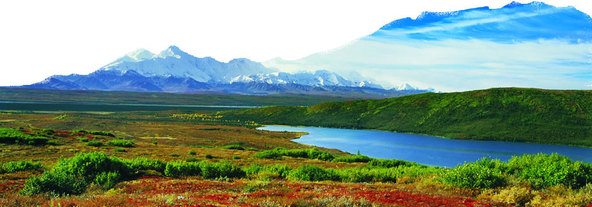

 Fairbanks
Fairbanks
